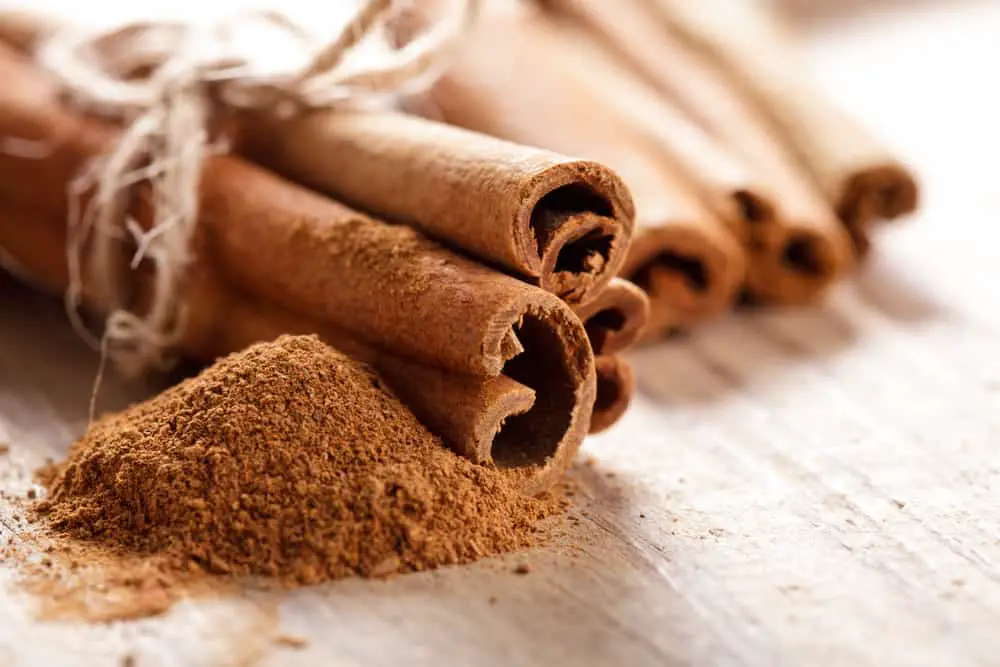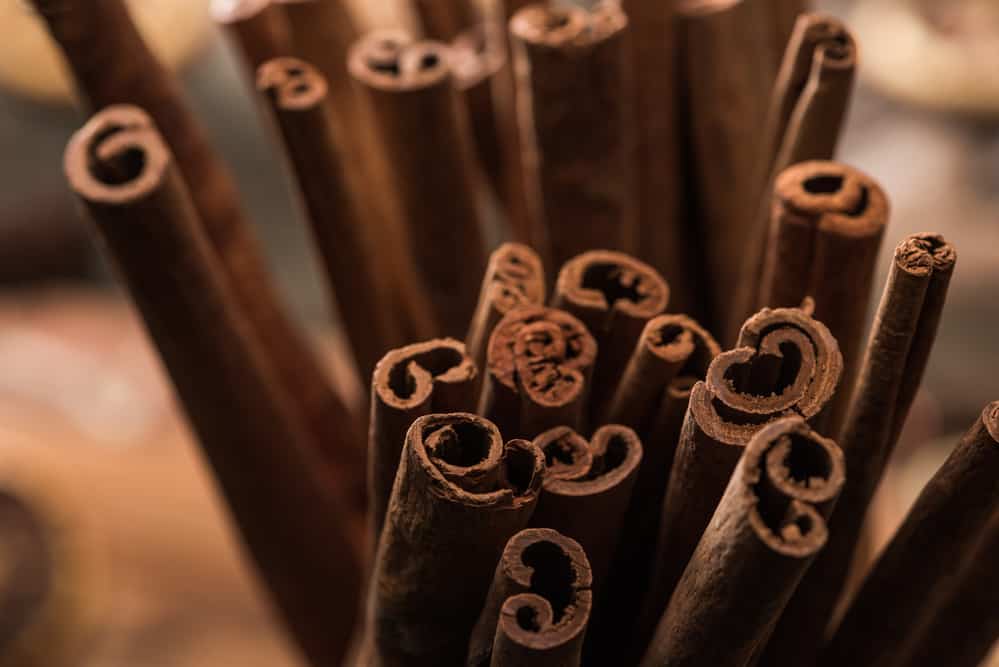Cinnamon, along with nutmeg and hazelnut, is one of the most popular spices when it comes to sweets. From sweet cinnamon rolls to spiced cookies to pumpkin-spiced drinks, there is no escaping this warm, sweet spice. Although ubiquitous throughout our lives, it does seem as if this spice is rarely thought about in terms of its origins and how it is made. With this in mind, what is cinnamon?
Cinnamon is a spice made from the bark of species of the cinnamon tree. It can be purchased in its reddish-brown ground form or in the form of curled sticks (quills). The word can legally be applied to both true cinnamon and cassia.
In this guide, we will be exploring another popular ingredient/topper for a variety of sweet dishes. Cinnamon has many different uses, and surprisingly, comes in a few different varieties. Read on to find out all there is to know about this mainstay spice.
Where Is Cinnamon From?

Cinnamon and cassia have been used as a spice for thousands of years, even utilized during embalming in ancient Egypt and scenting anointing oil in the Old Testament. It was brought to these areas via land and sea spice routes from India and China, but the sources were kept secret by Arab spice traders.
It is one of the spices that led European explorers to seek sea routes to Asia and the spice islands. Eventually, Portuguese explorers found the source in Ceylon and gained control of the trade. Wars followed that then turned control over to the Dutch and then the British.
Basics
In North America, the most common spice labeled as cinnamon is actually cassia, also known as Chinese cinnamon. It is harvested from the bark of the evergreen Cinnamomum aromaticum tree, which is native to southern Bangladesh, China, India, Uganda, and Vietnam. Cassia is cheaper to produce and has a bolder, less subtle flavor than true cinnamon, so it is sometimes referred to as “bastard cinnamon.”
The spice more correctly known as cinnamon is harvested from the inner bark of the Cinnamomum verum tree. It is also known as Ceylon cinnamon, a reference to its native country of Sri Lanka (which was formerly known as Ceylon). It is commonly grown in Sri Lanka, India (particularly in the southern state of Kerala), Bangladesh, Brazil, Vietnam, Madagascar, and other countries.
Ceylon cinnamon has a delicate, nuanced flavor that works well in sweet and savory foods and drinks. It has a paler color than cassia and is composed of many thin layers of bark rather than a single coiled strip of bark. True cinnamon is soft enough to be ground in a (clean) coffee grinder.
Other varieties of cinnamon include Cinnamomum aromaticum (a close relative of Ceylon cinnamon), Saigon cinnamon (also known as Vietnamese cinnamon or Cinnamon loureiroi), camphor laurel (Cinnamomum camphora), malabathrum (Cinnamon tamala), and Indonesian cinnamon (Cinnamon burmannii).
We will discuss a few of these in more detail below.
Cinnamon has a warm, sweet flavor and pungent aroma. The taste and scent come from cinnamaldehyde, which makes up most of the essential oil but also 80 additional aromatic compounds. Cassia has a stronger flavor than the more subtle true cinnamon, which can have floral notes.
If you see cinnamon on the ingredient list for recipes in the U.S., you can safely assume it refers to the common cassia type from the supermarket. Some recipes call for cinnamon sticks (quills) while others call for the ground (powdered) spice. Ground cinnamon can be added before cooking or baking as it will maintain its flavor and aroma.
When flavoring drinks, a cinnamon stick can add flavor without overpowering the other ingredients. Or a sprinkle of the ground version can be used to top a hot drink such as hot chocolate, mocha, or latte.
Types Of Cinnamon

Cinnamon is separated into two main categories: cassia and Ceylon. While both are harvested in sheets found beneath the bark of trees belonging to the same scientific family, they produce distinctly different products.
The two types are differentiated by the way they are harvested, their taste, their smell, and the chemical compounds found within them. Cassia cinnamon is what you probably know as cinnamon, the ground red-brown powder that’s found in spice cabinets and suburban grocery stores across the country and the world.
Before its ground, when it’s in bark-like form, cassia is rougher in texture, darker in color, and rolled in thicker sheets than Ceylon. Cassia’s potency is what made it the go-to for home cooks and industrial producers—it has a more intense flavor, so a little bit of that special powder goes a long way.
There are three specific types of cassia—Indonesian, Chinese, and Saigon—all with different levels of flavor and situations that they are best suited for. Indonesian cassia is the sweetest and most mild of the cassia cinnamons and is the most common in America. Chinese cassia, on the other hand, has a strong, bitter flavor.
Chinese cassia isn’t as common in the States and is mainly used medicinally in China. And then there’s Saigon cassia, which is intensely fragrant and flavorful, almost spicy, and generally our preferred cassia variety.
Let’s take a closer look at these popular types.
Ceylon
Often called true cinnamon, Ceylon cinnamon, or soft cinnamon, this variety is native to Sri Lanka and Southern India, but is widely grown in Mexico and East Africa. It is also sometimes called soft cinnamon because of its soft texture. If you hear the term Mexican cinnamon, this is often what it refers to.
Saigon
This is most often found on supermarket shelves as Saigon cinnamon. It originates from Southeast Asia. It’s pretty sweet, not super spicy. Most of what’s imported as Saigon cinnamon is actually Cinnamomum cassia, grown in Vietnam. “Saigon” is a misnomer because it was actually the trading point – there is no cinnamon grown near Saigon.
Royal
Sometimes called Royal cinnamon, this is harder to find on grocery store shelves, but spice purveyors often sell it. It’s mostly grown in central Vietnam. It’s super sweet, super spicy.
Fun fact: The area that Burlap & Barrel gets it from used to be the provider to the royal court — hence the name, Royal cinnamon.
Korintje
Sometimes called Korintje cinnamon, this one is generally milder. It is very common in America — it accounts for close to 70 percent of North American imports. It can best be described as a friendly cinnamon that works for everything.
Nutrition and Health Benefits

Cinnamon is thought to have many medicinal and soothing properties and is used frequently in Chinese herbal medicine. The distinctive smell and flavor derive from the essential oils contained in the bark, called cinnamaldehyde. Cinnamaldehyde displays antiviral, antibacterial, and anti-fungal properties.
Some spices, including this one, have prebiotic properties. These bacteria may help restore the balance of bacteria in your gut, support digestive health and alleviate any digestive issues.
There is some evidence to suggest that the consumption of cinnamon is associated with a short-term reduction in blood pressure. Although the evidence is hopeful, it is early days and more long-term random controlled trials are needed.
This spice has a reputation for helping manage blood sugar. It appears to do this by a number of different mechanisms, including managing the amount of glucose that enters the bloodstream and mimicking the blood sugar management hormone, insulin.
Human trials are promising and suggest this spice may have a moderate effect on lowering fasting blood sugar levels in those with diabetes.
Conditions like Alzheimer’s are more common as we age, and are characterized by a progressive deterioration of brain cells. In Alzheimer’s, the accumulation of protein fragments in the brain acts by slowing how a person thinks and remembers.
Cinnamon contains two compounds that appear to inhibit the build-up of these proteins. Much of this evidence is derived from animal studies, so there is still more for us to learn with regard to the effects on humans.
Cinnamon Safety
For the majority of people, this spice is generally recognized as safe when consumed as a culinary spice and in small amounts – no more than one teaspoon per day is considered safe for most adults, with less for children. In rare circumstances, some people may experience allergic contact dermatitis.
It’s worth remembering that most of the product purchased from supermarkets is a variety called Cassia cinnamon – this has a stronger taste and is cheaper to buy. However, it is high in compounds called coumarins, which in large doses may cause toxicity.
Ceylon, or ‘true’ cinnamon, has relatively low levels of coumarins and may be better tolerated.
If consumed in large amounts, this spice may interact with prescribed medication, including those for diabetes, and heart and liver disease.
If you’re on prescription medication, have a relevant medical condition, or have other related concerns, we would recommend speaking to your GP for further guidance.
Cinnamon and Diabetes: A Closer Look
Significant scientific research has been done to see if cinnamon is effective in treating a variety of diseases and conditions, but none has had results that support using it as a treatment as an alternative to conventional medical care. For those with Type 1 or Type 2 diabetes, this spice has not been proven to help in the long-term control of blood sugar levels.
Supplements containing cinnamon, calcium, and zinc did not help control high blood pressure in people with Type 2 diabetes. There is a concern that cassia contains coumarin, which in large quantities can worsen liver disease in those with that condition.
Cinnamon is used for a variety of purported health benefits in alternative medicine. These include treatment for colds, digestive problems, and painful menstrual periods. In traditional medicine, it has been used for bronchitis.
Using Cinnamon In Baking

This spice is used widely in both sweet and savory dishes. If you are looking for a savory application, try using Ceylon cinnamon (Cinnamomum verum) as it lends itself to savory dishes. Used in rice, in tomato sauce, is a great option as it’s often an unidentifiable secret ingredient that makes a dish taste more complex and interesting.
Think of Cinnamomum verum and Cinnamomum loureiroi as your two extremes from savory to sweet with everything else in the middle.
You can often find it in dishes as robust as Cincinnati chili, Middle Eastern dishes like Shish Tawook, or Indian dishes like Lamb Vindaloo. It commonly appears in many curries as well.
If you are unsure about the type you are using, or you are testing out a new brand, it is recommended to make a quick tea to test out the flavor and strength. Take a teaspoon and pour over hot water, let it infuse, and taste it–it should be sweet and spicy. If it isn’t, it isn’t worth using or you’ll need to use more to get the same intensity of flavor.
When it comes to baking and for sweeter dishes in general, try using the Saigon or Royal types, which you may find to be amazing in buns and snickerdoodles and really any dessert-like oatmeal cookies or a variety of coffee cakes.
As for cinnamon sticks, use them more for appearance than flavor. After all, they are just a perfectly rolled piece of tree bark.
And don’t forget to replace your product (and most of your spices) after a few months to a year as they lose their pungency. It’s better to buy smaller amounts, more often.
Storing Cinnamon
Store this spice in a cool and dry place, sealed tight. A cupboard in the kitchen or a spice drawer both is great options.
Once you open the package, consider transferring the spice into a resealable bag or jar if yours isn’t. Or at least wrap the top (if it’s a small plastic package) to minimize access to fresh air.
As long as you won’t let water, pantry bugs, or any other contaminants get to your spice, it should stay just fine for months or even years.
If you’re using a spice rack, make sure it sits away from direct sunlight and the stove. Both make the flavor dissipate quicker. And keep it on that rack only if you use it frequently (i.e., you refill the jar every couple of months). Pretty much all packages of ground cinnamon come with a best-by or best-before date on the label. That date indicates how long, at the very least, the product should stay fresh.
Of course, since ground cinnamon is a powdered spice, you can easily store it for years past that date. However, like other spices, it can lose some of its flavors over time.
At some point, you might notice that you need to add much more ancient cinnamon than you used to when it was fresh.
Generally, try to finish the package within a year past the best-by date to get the best quality.
How to Bake With Cinnamon

Cinnamon gets its flavor and aroma from an essential oil that makes up about 0.5% to 1.0% of its composition. In cinnamon, the leaf and bark oils have entirely different flavor profiles and qualities, and one cannot be substituted for the other. There are many blends available that are imitation flavorings and could be distinguished through sensory and instrumental analysis.
Worldwide, it is used mostly as a culinary ingredient. The bark oil is used in commercial manufacturing of baked goods and confectionery, while cinnamon-based oleoresin is used to create cake mixes and convenience foods. Cassia oil may be used, but less frequently, in bakeries and confectionery. Cassia buds, similar in appearance to tiny cloves, are used in confectionery and purported to taste as good as the bark.
Apart from flavor, it is also used in commercial baking to impart a specific color to a product. For certain purposes, it may be desirable to give a baked product high cinnamon coloring and yet only relatively mild cinnamon flavoring. In this case, you should look for a red-colored variety (cassia) with moderate oil content, or perhaps a blend (in which two or more grades are mixed to give the desired performance).
The blending of different varieties or grades to create tailor-made cinnamon for various types of baked goods has become standard practice, provided the blends are formulated properly, they have many advantages.
Finely ground cinnamon is ideal for use in flavoring baked goods, although the bark oil may be used for commercial applications because it can be measured more accurately. In the United States especially, cinnamon mixed with sugar is commonly used to flavor apples (apple pie), cereals, and baked goods such as doughnuts, pastries, and sweetbreads. Its primary culinary use is as a flavoring.
The flavoring component exists in cinnamaldehyde, which is responsible for cinnamon’s distinctive scent and taste. It is also volatile at high temperatures. The flavor can both degrade and evaporate at high heat. This can alter the taste of the baked good.
Using excessive amounts will delay fermentation and the proofing of dough due to the spice’s antifungal properties. It can also cause the dough not to rise at all. Most of the time, yeast levels have to increase, for example in cinnamon rolls, to compensate.
However, its antimicrobial properties are said to be responsible for limiting the growth of Listeria and E. coli in foods, which can extend a product’s shelf life.
Can Dogs Have Cinnamon?
The simple answer is that it is nontoxic to dogs, cats, and horses, according to the ASPCA. Of course, you don’t want to feed your dog table scraps or foods that have a large quantity of the spice, since this type of people’s food may leave your pet with an upset stomach.
And while it might not be toxic to dogs, it’s likely that the same treat contains plenty of other ingredients that are.
While this spice isn’t toxic for dogs, but nutmeg can be if consumed in large amounts. In excessive amounts, nutmeg causes hallucinations and a high heart rate in dogs. Interestingly enough, it can have the same impact on people.
Your recipe for a decadent treat might contain chocolate along with cinnamon, and chocolate in any amount is an absolute no-no for dogs.
And cinnamon buns are often made with raisins and other ingredients that are toxic to dogs, such as raisins or macadamia nuts.
If you want your dog to enjoy a treat, there are plenty of dog biscuits that combine this spice with other dog-safe ingredients, like apples, turkey, sweet potatoes, and pumpkin.
Can Cats Have Cinnamon?

This spice in particular may seem harmless or even healthy since it does have some health benefits for human beings. Sadly, that’s not the case when it comes to kitties.
The ASPCA hasn’t labeled it as toxic to cats and other animals.
However, it can still trigger an allergic reaction and cause various complications. In other words, you shouldn’t allow your cat access to the spice in any of its following forms:
- Powdered spice
- Essential oil
- Cinnamon tree
- Dried sticks
- Diffusers and infused air fresheners
- Human foods spiced with cinnamon
This spice can be bad for your fur ball as it can lead to numerous health complications. It contains a compound called coumarin. Your cat’s body can’t break it down, which results in liver failure and other problematic outcomes.
Fortunately, there aren’t high concentrations of coumarin in the most common type of cinnamon in households (powdered).
Nevertheless, this spice in all of its forms can still pose harm to cats in three basic ways – inhaled, ingested, or rubbed on the kitties’ fur and skin.
Basically, there is no version that’s safe for cats or other pets. Inhaling, ingesting, or touching these compounds in any way can pose danger to your fluffy friend. Regardless of its age, breed, or overall health condition, the kitty must stay away from it.
In all honesty, it is best to just avoid giving pets such a specialty food as this. It is better to be safe than sorry.
